ktops is no longer a daring outlier—it’s a value-adding classic that designers expect to keep rising through 2025. Recent market analyses link deep, inky palettes to higher selling prices and faster closings, while color-trend forecasters celebrate the mix for its drama, cleanliness, and versatility. Against that backdrop, the following ideas show how black kitchen cabinets with white countertops can brighten small rooms, ground expansive spaces, and flex across styles from minimalist to industrial without sacrificing practicality.
1. Bold Contrast: Black Kitchen Cabinets Meet White Quartz Countertops
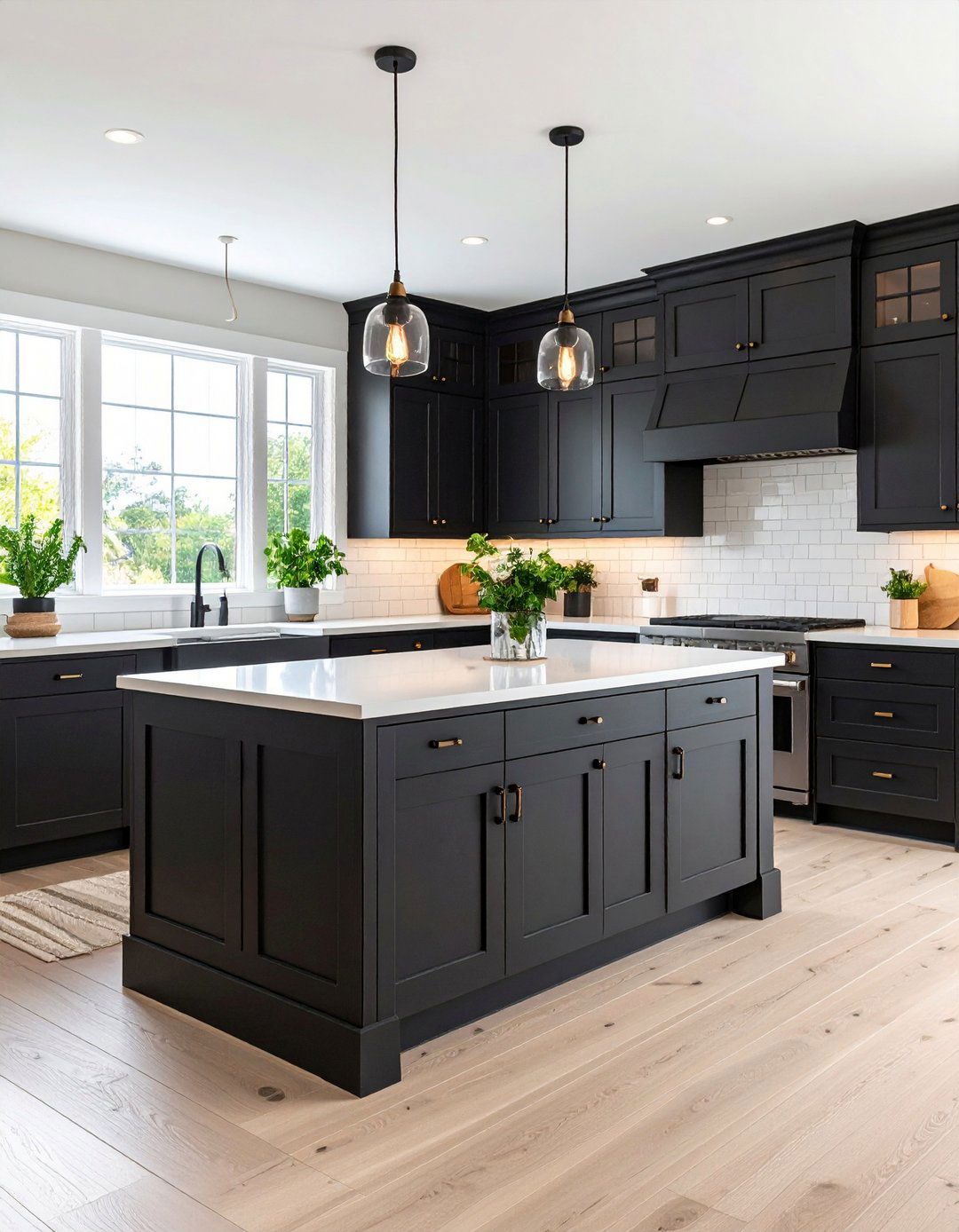
A first glance reveals why contrast reigns supreme: black kitchen cabinets form a luxe backdrop that lets white quartz countertops gleam like sculpted stone. Starting with sharp light-dark division immediately telegraphs sophistication and makes every fixture pop. Designers highlight this pairing as an instant “wow” moment that works in modern lofts or farmhouse refreshes because the duo reads timeless rather than trendy. To avoid a stark feel, layer one or two bridging neutrals—think soft grey backsplash or pale wood flooring—that dilute the edge just enough while keeping the visual punch.
2. Brightening Tricks for Black Kitchen Cabinets and White Surfaces

Although black kitchen cabinets absorb light, strategically placed reflective materials keep white countertops luminous and the whole room airy. Swap heavy drapes for translucent blinds, integrate a high-gloss subway-tile backsplash, and bounce daylight off polished nickel faucets to multiply brightness. If natural light is scarce, install LED strip lights along toe kicks and under shelves to graze the cabinets’ surface, outlining their form without glare. Lighter flooring—bleached oak, pale terrazzo, or travertine-look porcelain—also counteracts any visual “shrink” that dark cabinetry can create, preventing a cave-like vibe.
3. Choosing Hardware That Elevates Black Kitchen Cabinets

The right pulls and knobs transform black kitchen cabinets from basic to bespoke. Matte black hardware disappears for a monolithic effect, while burnished brass or brushed gold punctuate the darkness with jewelry-like sparkle—both finishes headline 2025 hardware forecasts for their fingerprint resistance and modern edge. Test sample pieces in different sizes; oversized bar pulls feel contemporary, dainty latches lean heritage, and mix-and-match suites add a crafted vibe. Whichever route you take, align finishes on faucets and lighting for cohesion, but don’t fear a secondary metal for depth—balanced variety reads curated, not chaotic.
4. Warm Metallic Accents on Black Kitchen Cabinets
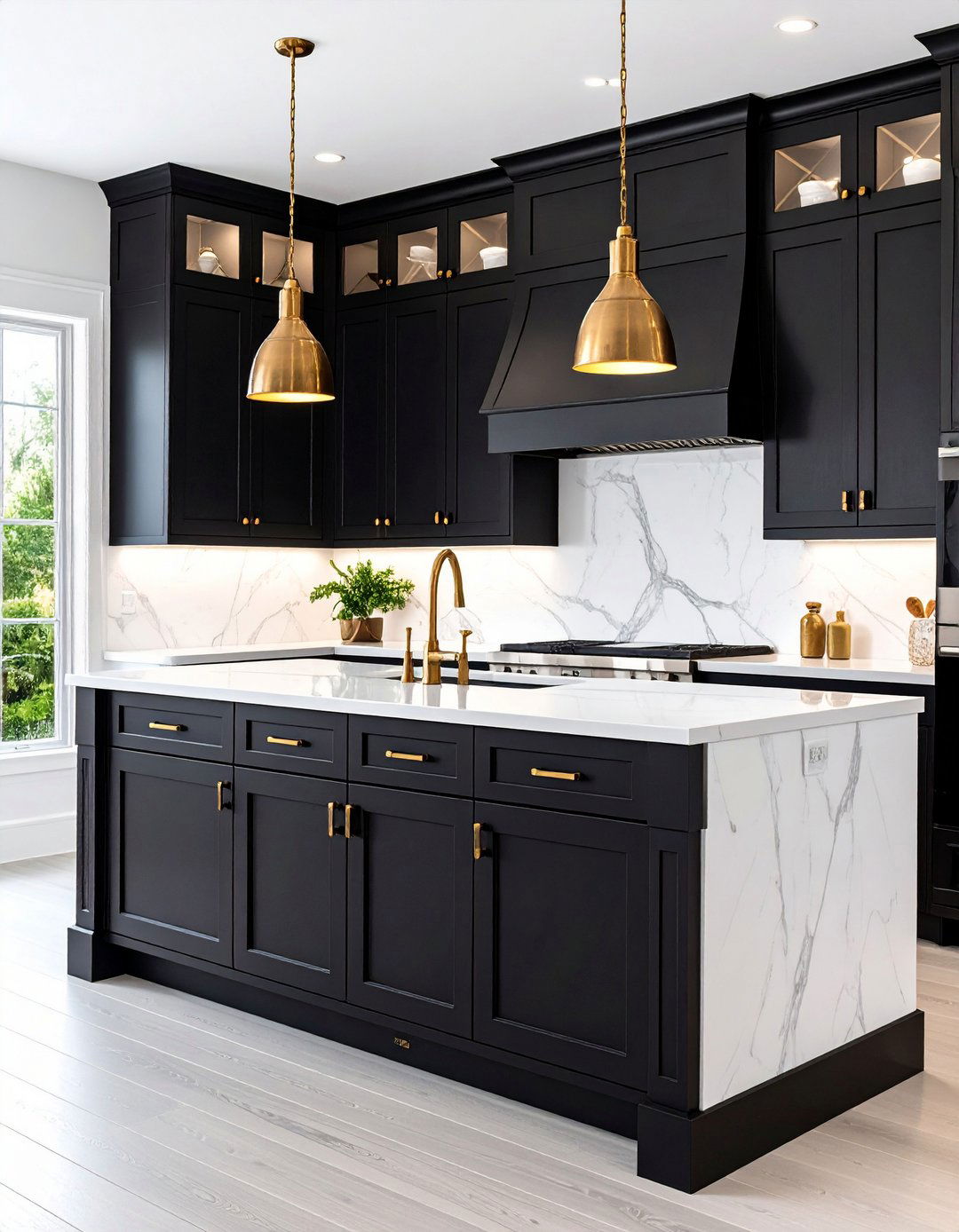
Soft brass sconces, copper range hoods, and champagne-bronze faucets warm up black kitchen cabinets without muting their richness. Designers caution against uniform metals—matching every hinge, knob, and light can date a room—so treat brass or copper as an accent sprinkled across eye-level and countertop zones. Satin brass pulls against ebony shaker doors feel instantly classic, while hammered copper pendants bathe glossy white countertops in a flattering glow. Carry a secondary cooler metal, such as stainless steel, on appliances to prevent an overly yellow scheme, and anchor both tones with matte black door hinges for balance.
5. Mixing Open Shelving With Black Kitchen Cabinets
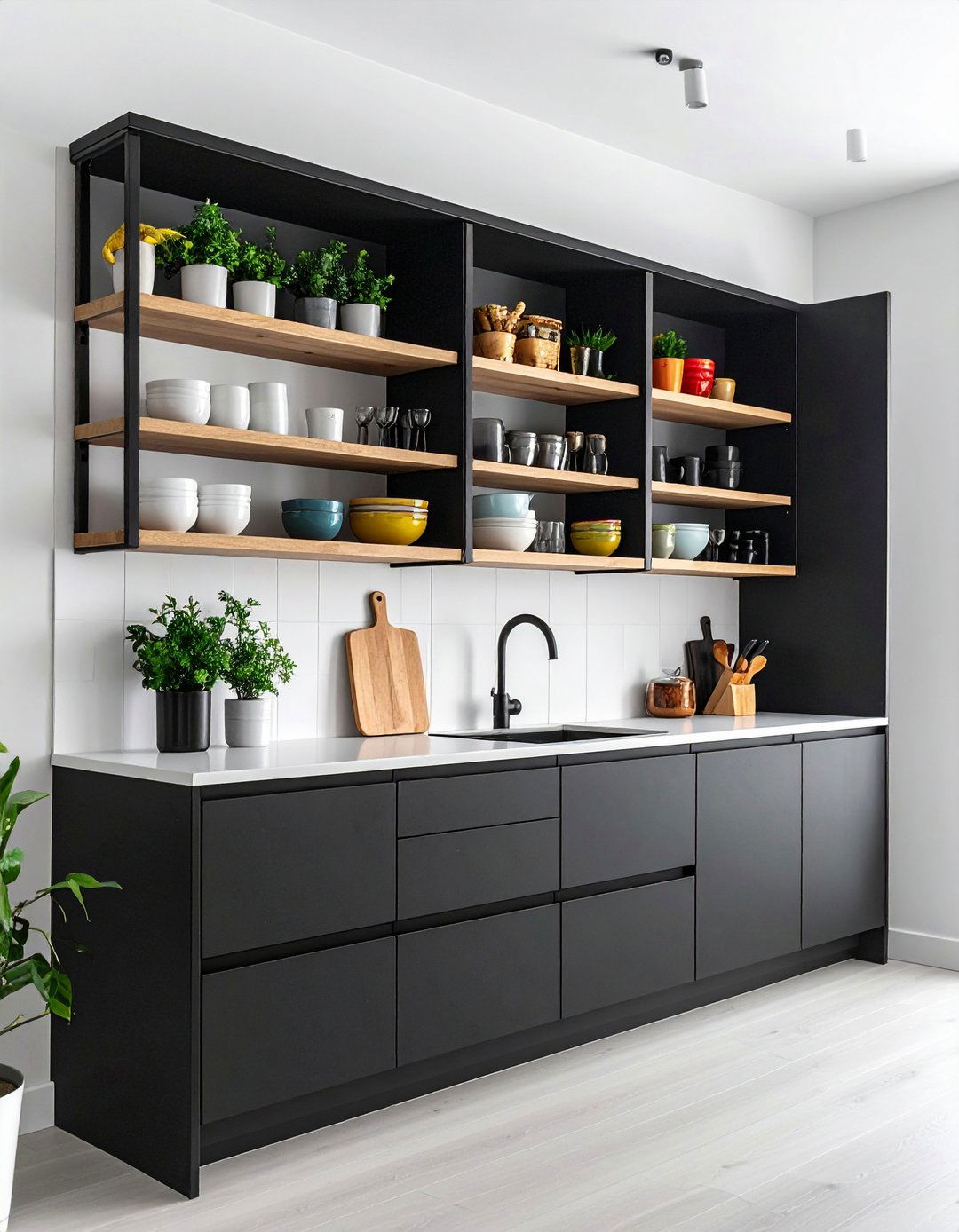
Open shelves break up large blocks of black kitchen cabinets and showcase colorful dishware against the purity of white countertops. Swap two or three upper doors for chunky white oak planks or slim powder-coated steel brackets; the negative space lightens the composition and provides quick-grab storage for daily mugs. Styling matters—cluster items by color or material so the display feels intentional, not cluttered. Even renters can test the idea by removing doors temporarily and storing them safely; interior cabinet boxes painted white enhance contrast and bounce light deep into shelves.
6. Matte vs. Gloss Finishes on Black Kitchen Cabinets
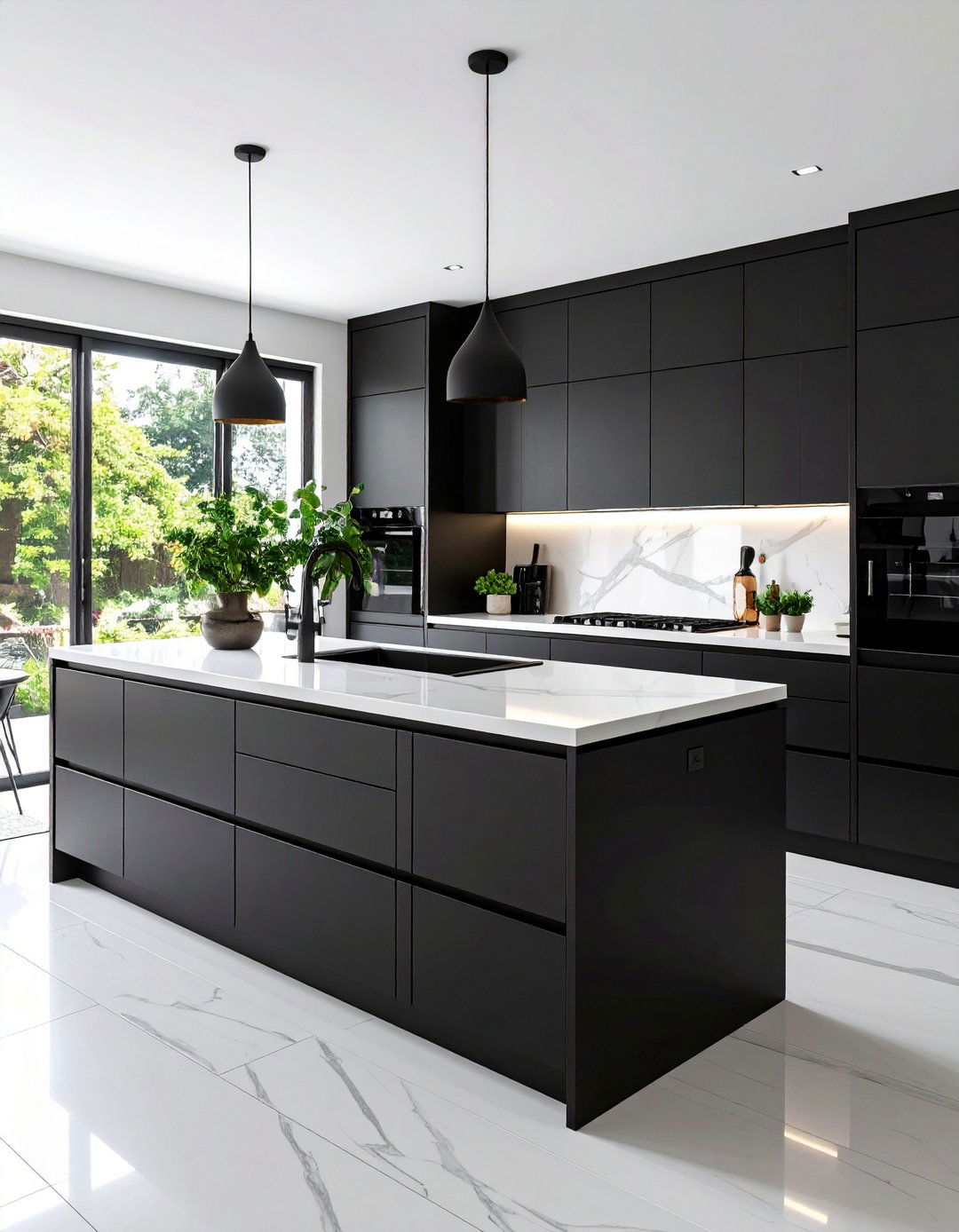
Finish sheen dictates maintenance and mood. Matte black kitchen cabinets exude modern calm and hide minor scuffs, yet they can highlight oily fingerprints. High-gloss lacquer reflects window light, visually enlarging tight footprints and allowing white countertops to sparkle even more, but it shows scratches sooner. A middle-road satin or semi-gloss offers durability plus easy wipe-downs—especially helpful near cooktops where splatter strikes. Whichever gloss you choose, seal edges with a clear acrylic topcoat to lock pigment and simplify cleaning, then match your cleaner to the finish to avoid cloudiness.
7. Adding Texture Through Shaker-Style Black Kitchen Cabinets

Flat-panel doors scream sleek, but shaker-style black kitchen cabinets introduce subtle shadow lines that soften the scheme and echo the beveled edges of thick white countertops. The added dimension prevents a wall of black from feeling oppressive, especially in windowless kitchens, and pairs gracefully with exposed beams or tongue-and-groove ceilings. Designers predict dark cabinetry—particularly with visible rails and stiles—will dominate 2025 remodels for its tailored yet approachable look. For extra character, swap one shaker door for fluted glass, reflecting just enough countertop brightness back into the room.
8. Layered Lighting for Black Kitchen Cabinets Over White Tops

Task, ambient, and accent lighting layers are non-negotiable when black kitchen cabinets meet white countertops. Hardwired LED puck lights under uppers chase shadows from prep zones, while strip lights inside drawers make utensils visible against dark interiors. Add decorative pendants in warm tones to soften edges and bounce light off glossy counters. Recent guides show under-cabinet kits as low-cost, energy-saving upgrades that install in minutes and dramatically improve visibility. Aim for 3000–4000 K bulbs to avoid a cold cast against white stone, and dimmers to adjust mood from chopping onions to pouring wine.
9. Flooring Pairings to Ground Black Kitchen Cabinets

Floor selection can make or break the contrast story. Designers often specify white-washed oak, pale maple, or light gray porcelain tiles because hues a shade or two lighter than black kitchen cabinets extend the eye upward and harmonize with white countertops. Patterned cement tiles—chevrons, checkerboards, or subtle geometrics—inject energy without competing for attention, especially when the palette sticks to charcoal, ivory, and soft beige. Ensure sheen is matte or low-satin so the floor doesn’t mirror cabinet reflections too sharply, which can feel busy. Continuous planks laid lengthwise in galley layouts reinforce line and elongate narrow rooms.
10. Backsplash Ideas Behind Black Kitchen Cabinets With White Countertops
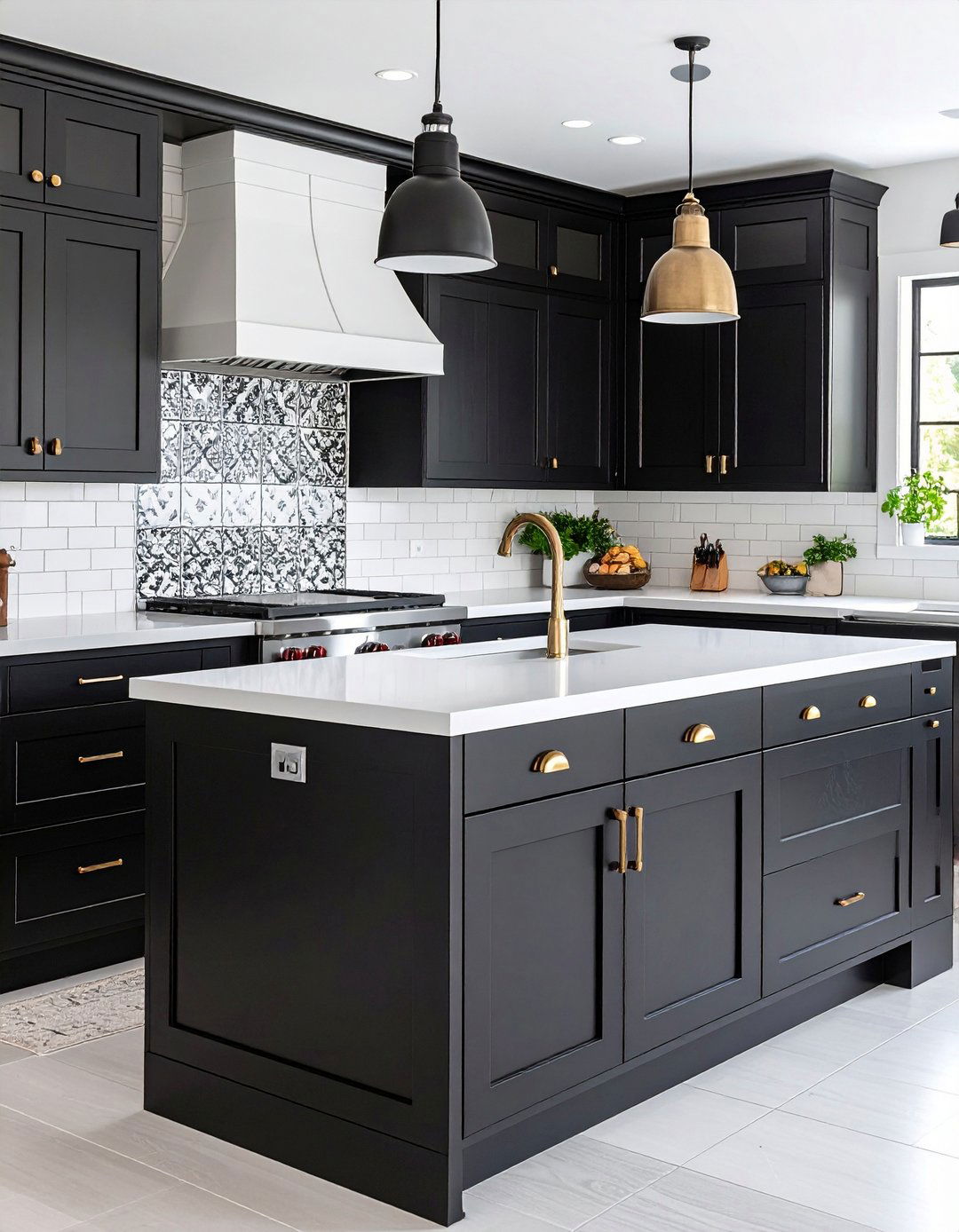
A backsplash bridges the dark-light divide and protects walls from splatter. Glossy white subway tile remains a timeless favorite because its reflective glaze amplifies the brightness of white countertops and echoes cabinet lines. Designers also champion gray or marble subway tile to soften contrast while preserving elegance. If you crave pattern, try black-and-white encaustic cement tiles or vertical stacked skinny rectangles—they add movement without overwhelming. Keep grout fine and color-matched to tile to avoid a grid that distracts from the cabinetry. Ceiling-height installation elongates walls and frames hood features like a custom piece of art.
11. Small-Space Solutions Using Black Kitchen Cabinets
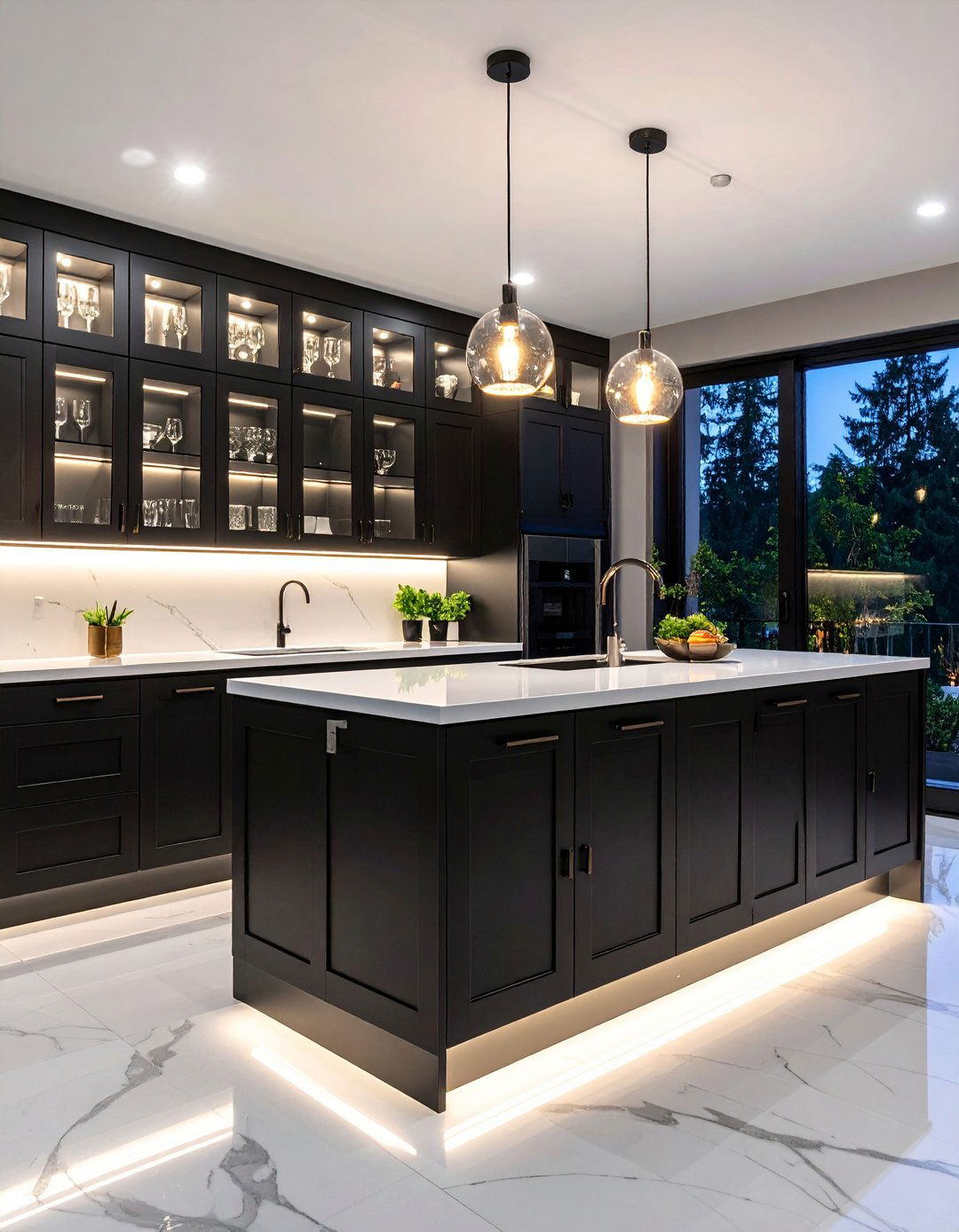
In compact kitchens, black kitchen cabinets need help to avoid visual compression. Limiting the dark tone to base units while installing white uppers preserves the dramatic vibe yet keeps sightlines open. Mirrored or metallic toe-kicks reflect flooring and make cabinets appear to float, and glass doors on a few uppers push depth further. Lighting again is critical; one designer trick is running LED tape along the underside of countertops to create a halo that visually lifts the cabinetry. White countertops with a light vein pattern prevent a heavy block of solid white, lending subtle texture.
12. Modern Minimalism With Sleek Black Kitchen Cabinets
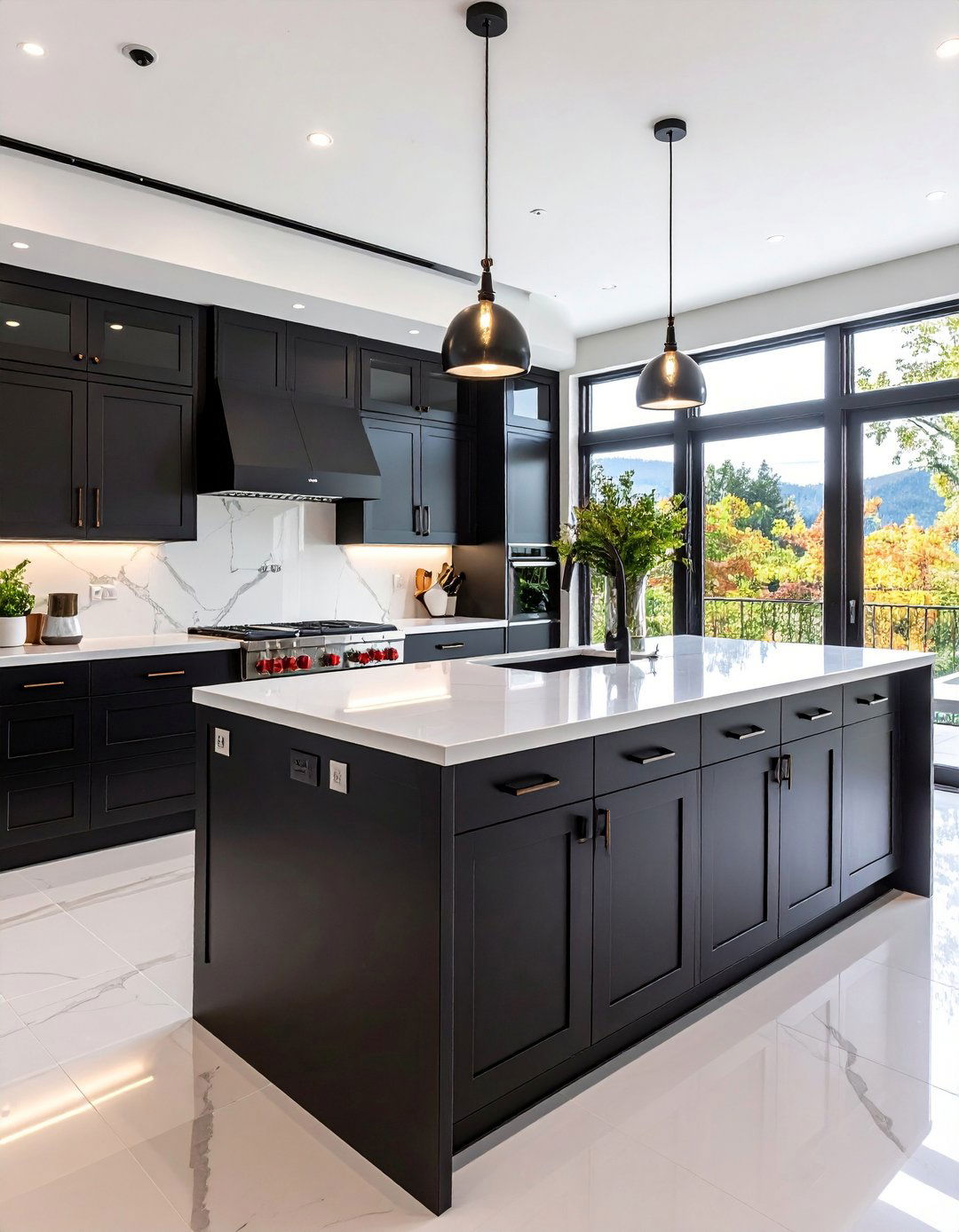
Modern minimalists gravitate to handle-less black kitchen cabinets whose integrated finger pulls keep faces uninterrupted, letting waterfall white countertops take center stage. Interior experts praise the scheme for placing cooking tools, not décor, in the spotlight and for allowing quick aesthetic updates via accessories. Consistent slab fronts coated in low-sheen paint visually recede, making the stone island appear sculptural. Keep color noise minimal—charcoal, chalk, and stainless—but play with material contrast, such as honed marble against matte paint. Cutting countertop clutter is essential; built-in knife blocks and recessed outlets maintain the clean plane.
13. Classic Elegance With Black Kitchen Cabinets and Marble White Tops
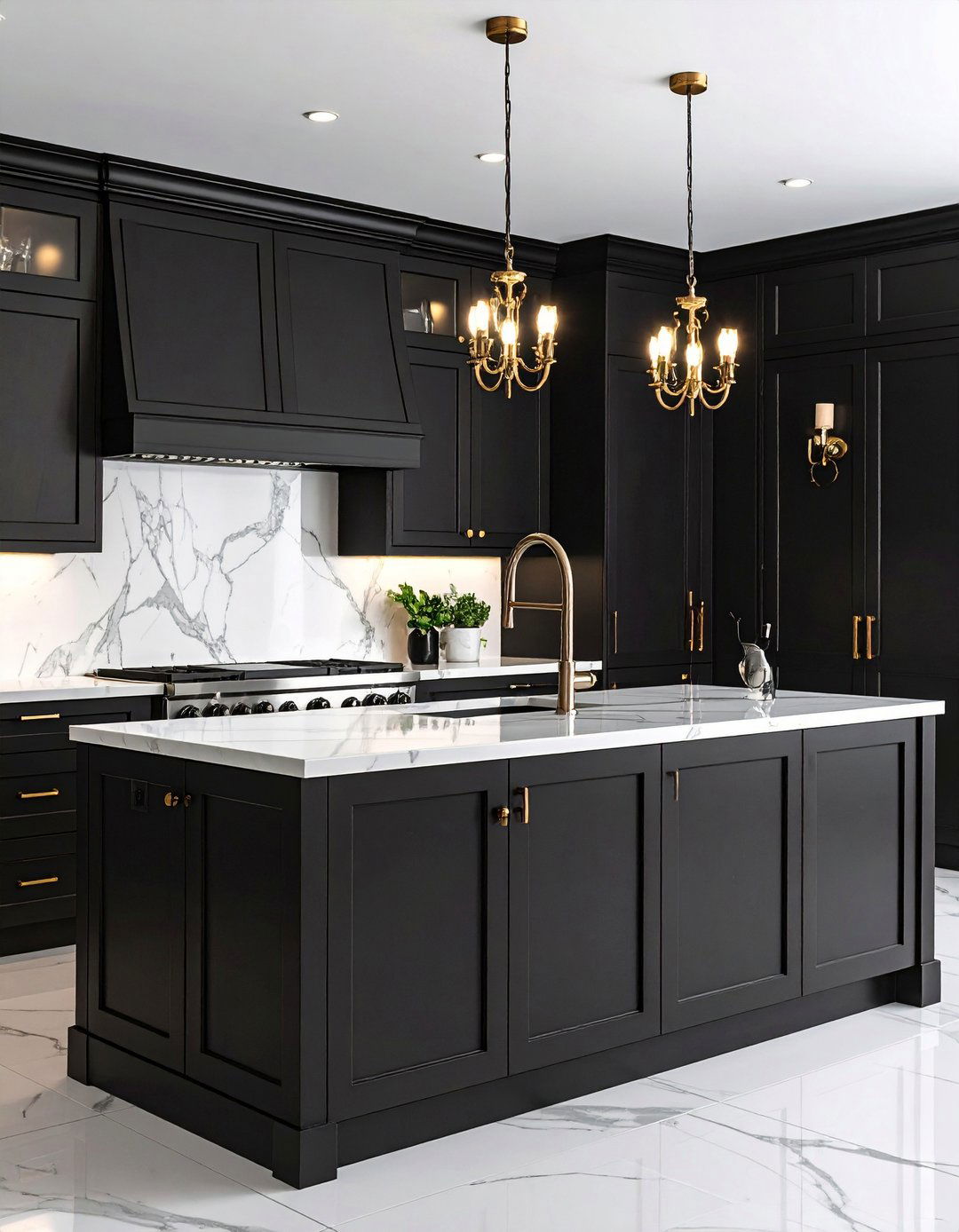
For lovers of timeless charm, black kitchen cabinets paired with white marble countertops recall European bistros and pre-war townhomes. Architectural tastemakers note how veined stone introduces organic pattern that enlivens the dark cabinetry’s solidity. Polished nickel bridge faucets and candelabra sconces accentuate heritage cues, while inset door construction lends furniture-grade sophistication. Balance old-world touches with modern conveniences—soft-close hinges, built-in charging drawers—to keep function current. Seal marble well and wipe spills promptly to preserve that crisp white canvas against the moody cabinets.
14. Industrial Edge: Black Kitchen Cabinets and Concrete Looks
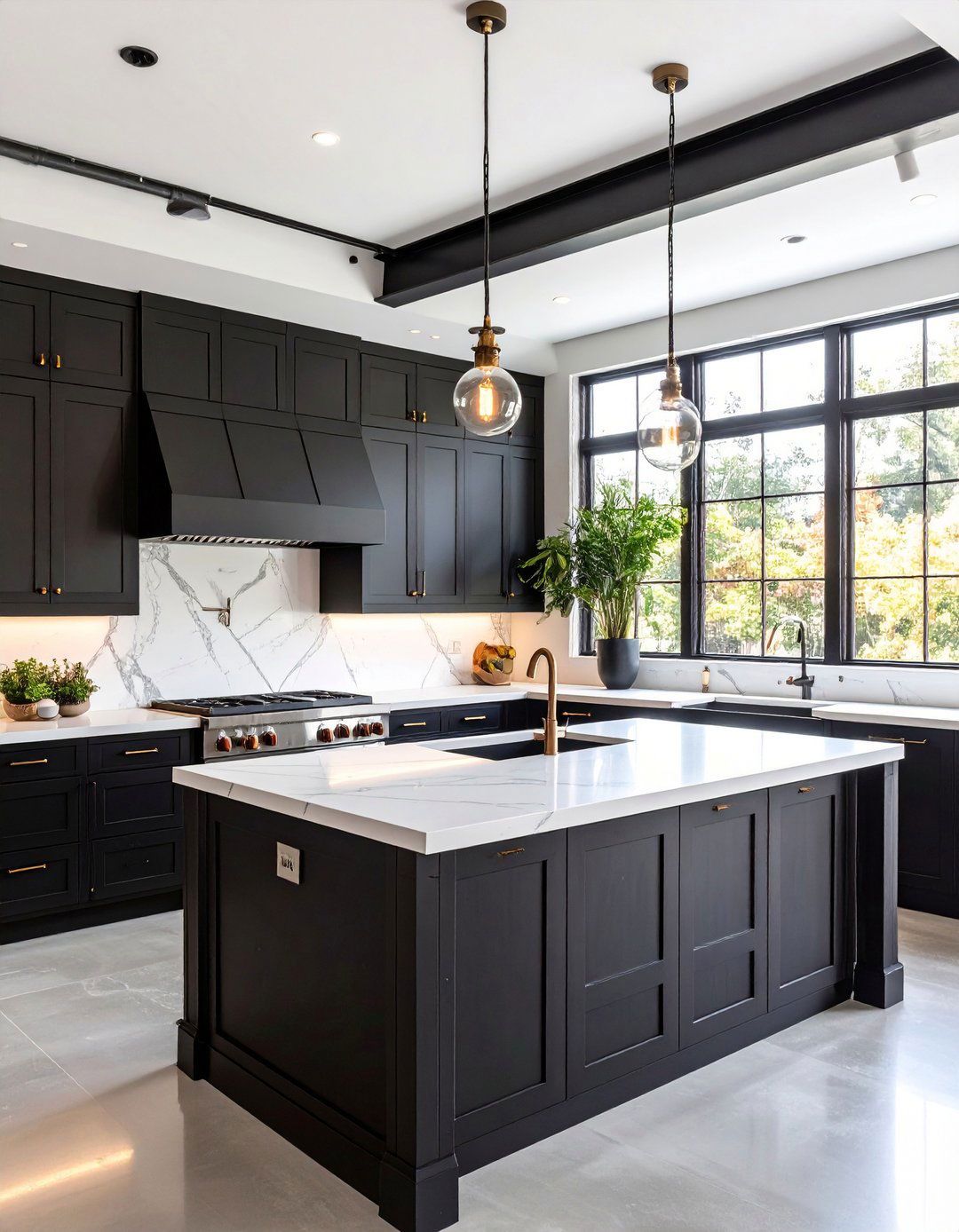
Channel loft character by pairing black kitchen cabinets with white quartz countertops veined to mimic concrete and layering in raw textures like exposed brick or steel pipes. Industrial design historians trace the popularity of black kitchens to warehouse conversions embracing cast iron and slate, making the palette feel authentic rather than forced. Vintage filament pendants, riveted stools, and reclaimed timber shelves soften the harder surfaces. Matte black cabinet pulls blend with doors, allowing rugged fittings—such as a salvaged iron pot rack—to grab attention. Keep open sightlines so statement structural elements remain focal points.
15. Two-Tone Islands Complementing Black Kitchen Cabinets
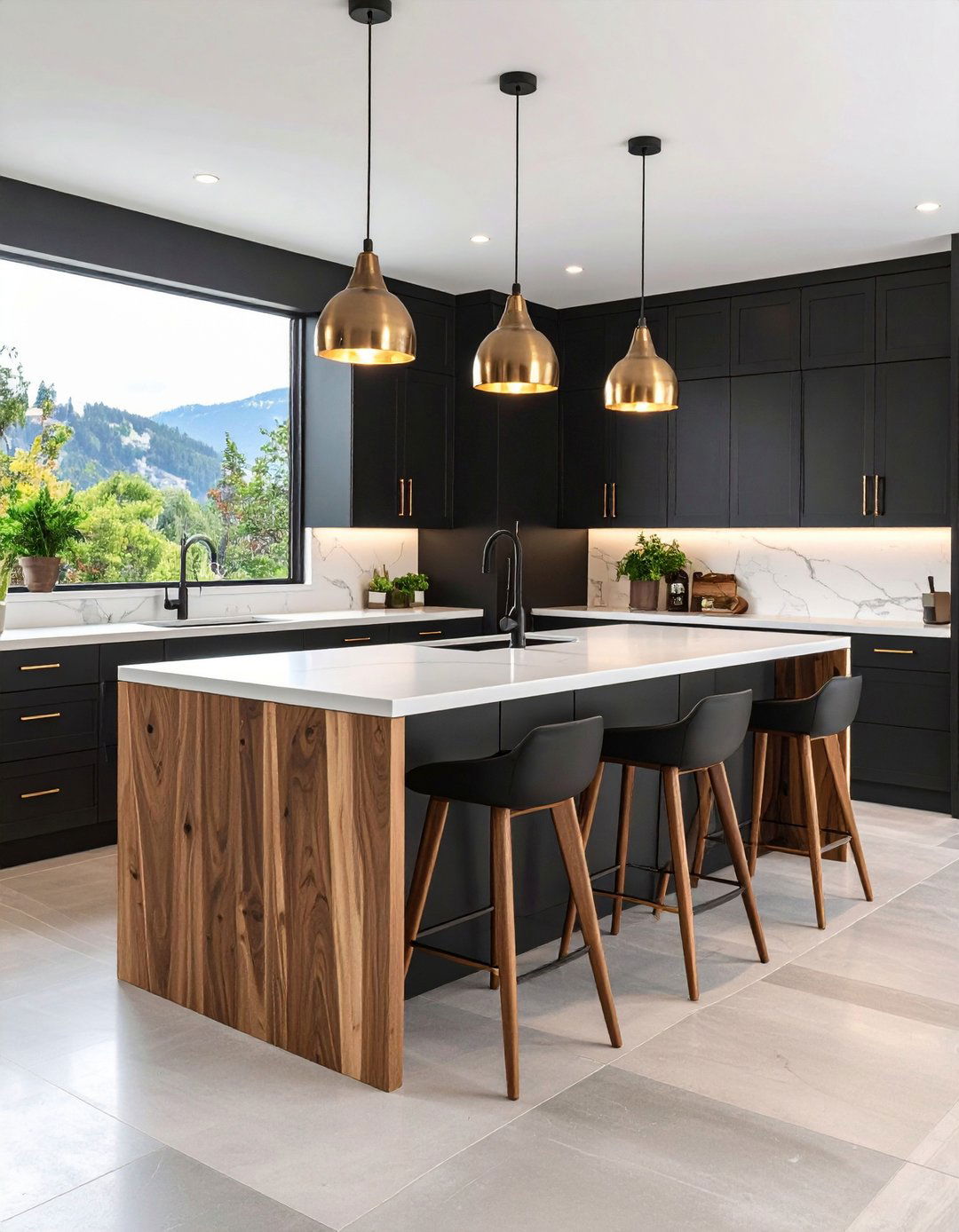
Introducing a contrasting island is an easy way to sample color while keeping perimeter black kitchen cabinets and white countertops intact. Try staining the island espresso and capping it with a waterfall white quartz top, or flip the scheme with a white base and honed black granite surface for functional prep. Designers love two-tone strategies because they break visual uniformity and define zones for dining, baking, or homework. Ensure crossover through hardware or stool finishes so the island belongs to the overall story rather than reading as an afterthought.
16. Cleaning and Care Tips for Black Kitchen Cabinets
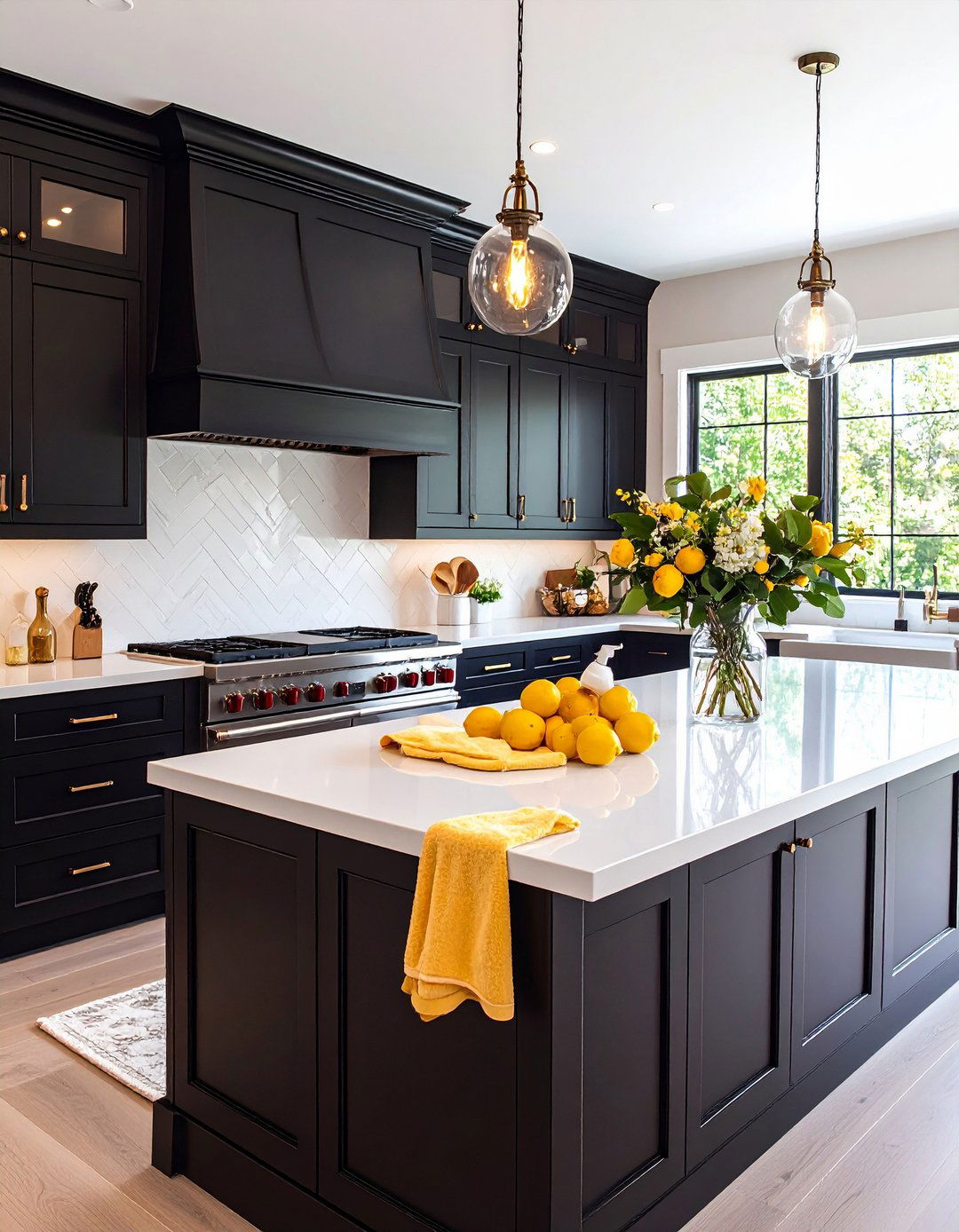
Daily upkeep keeps black kitchen cabinets crisp against pristine white countertops. High-gloss or semi-gloss finishes wipe clean with microfiber and mild soap; matte finishes resist scratches but may need a gentle citrus-based cleaner to erase fingerprints. Avoid abrasive pads that cloud dark paint and always follow with a lint-free towel to prevent streaks. Maintain countertop sealant, especially around sinks, to block water stains that stand out on white surfaces. When repainting touch-ups, match sheen exactly—mixing satin patches on a semi-gloss door will telegraph under overhead lighting.
17. Eco-Friendly Materials for Black Kitchen Cabinets
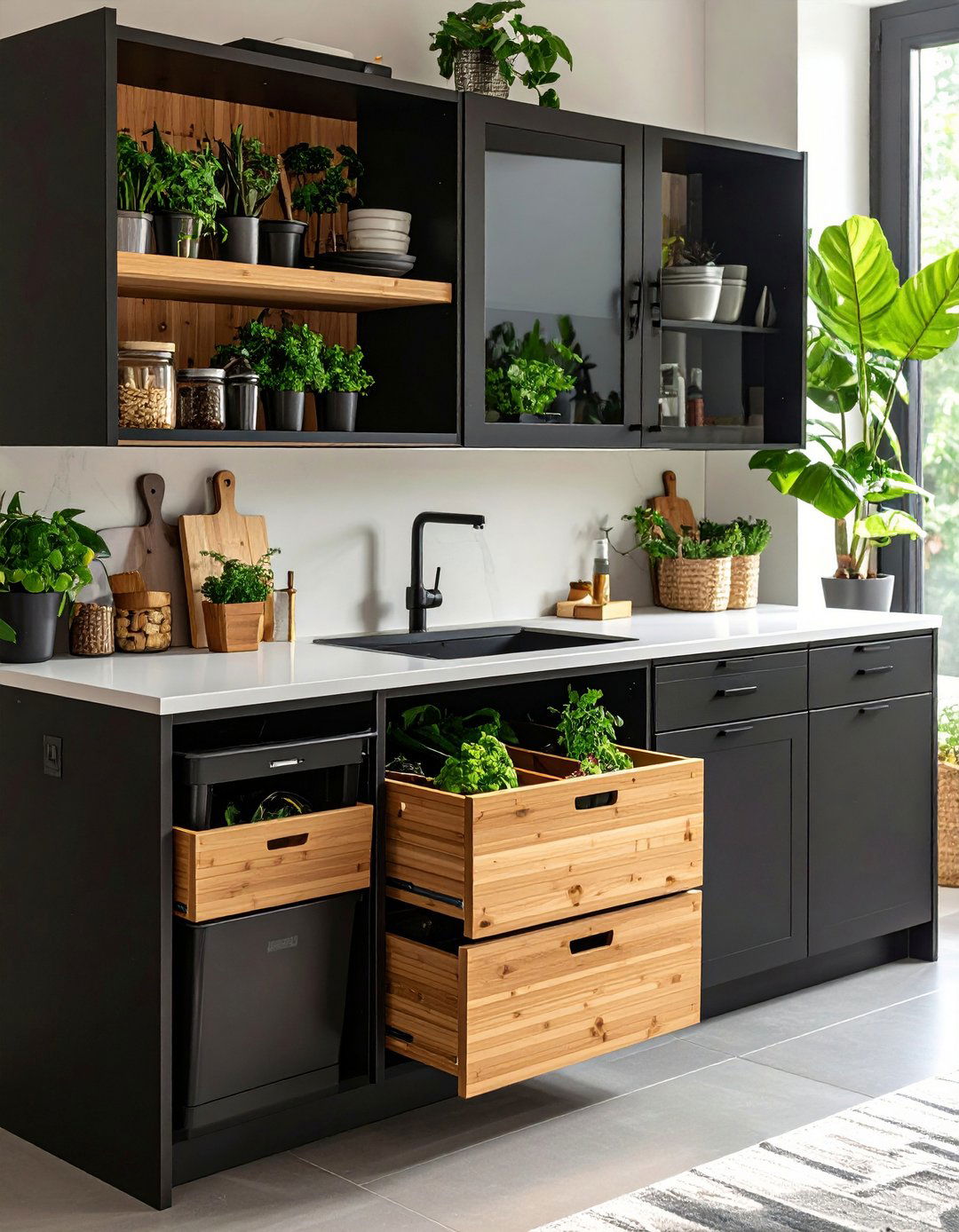
Sustainability-minded renovators can specify black kitchen cabinets built from no-formaldehyde plywood, bamboo veneer, or responsibly sourced hardwoods finished with low-VOC paints. Industry forecasts place durability and eco credentials at the heart of 2025 kitchen trends, encouraging homeowners to invest once and keep cabinetry out of landfills. Pair these greener boxes with recycled-content white quartz countertops or durable porcelain slab tops that mimic marble without quarrying new stone. Inside drawers, integrate compost bins and organized recycling centers so green intentions extend beyond materials to everyday habits.
18. Transforming Existing Cabinets Into Black Kitchen Cabinets

Painting dated oak or maple units is the most budget-friendly route to black kitchen cabinets crowned by fresh white countertops. Professionals recommend removing doors, labeling hardware, and sanding lightly to help bonding primer adhere; tinted primer prevents the old finish from bleeding through. Apply two thin coats of high-quality enamel with a foam roller for a spray-like finish, allowing full cure before rehanging doors. Finally, add a water-based polyurethane topcoat for scuff resistance. Swap faded knobs for modern pulls, and your cabinetry will rival a custom install at a fraction of the cost.
19. Budget and Resale Value of Black Kitchen Cabinets
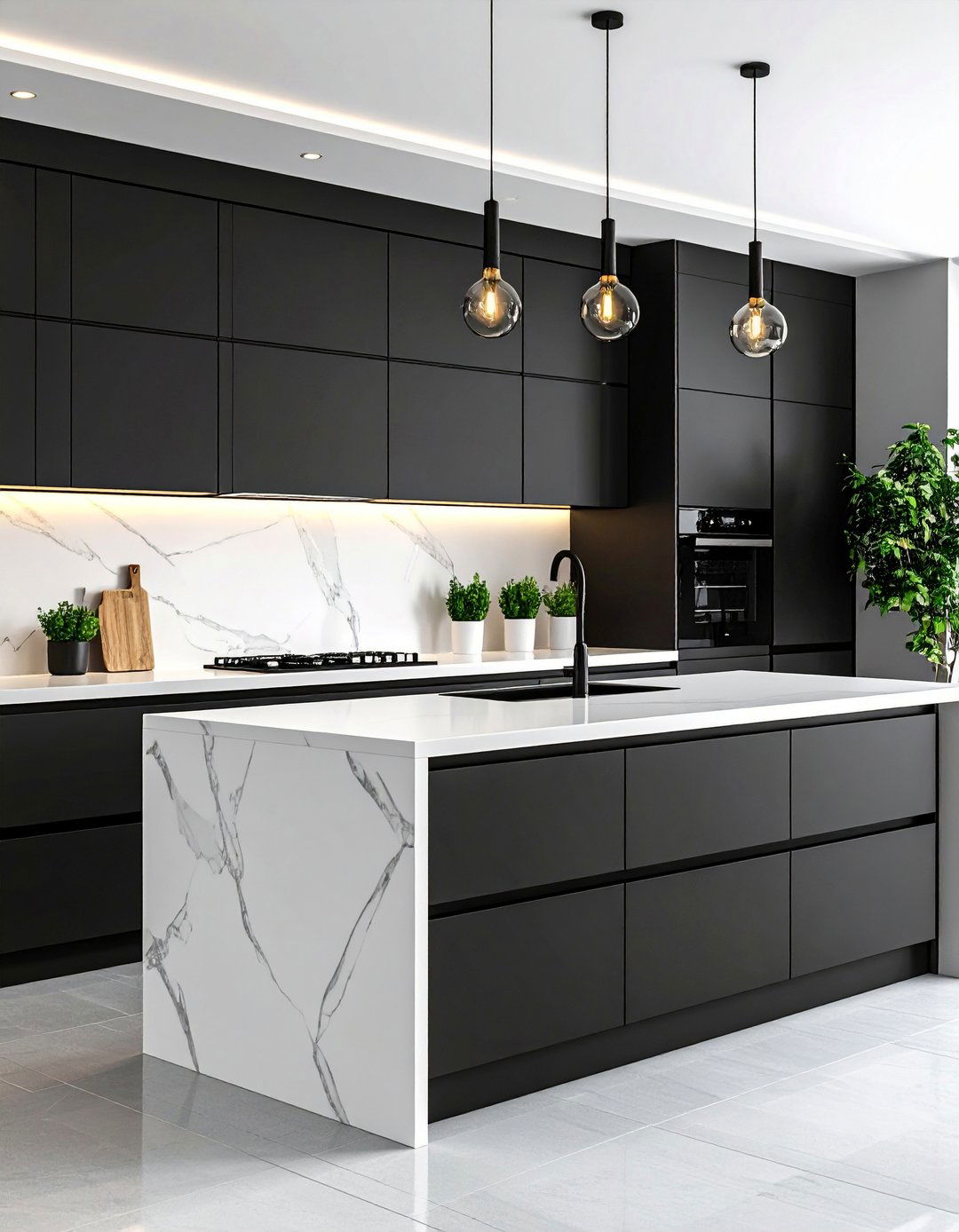
Contrary to fears that dark palettes limit buyers, real-estate data shows charcoal and black kitchen cabinets can increase appraisal values by thousands when balanced by bright elements like white countertops and good lighting. Market watchers link the scheme to perceptions of luxury, while analysts of “organic modern” style note that natural stone counters and rich cabinet hues help listings stand out in scrolling feeds. Invest wisely by choosing classic door profiles and quality hinges—shortcuts here erode ROI. Even small galley kitchens can capitalize on the trend and sell faster when staged to highlight contrast.
20. Personalizing Style Around Black Kitchen Cabinets
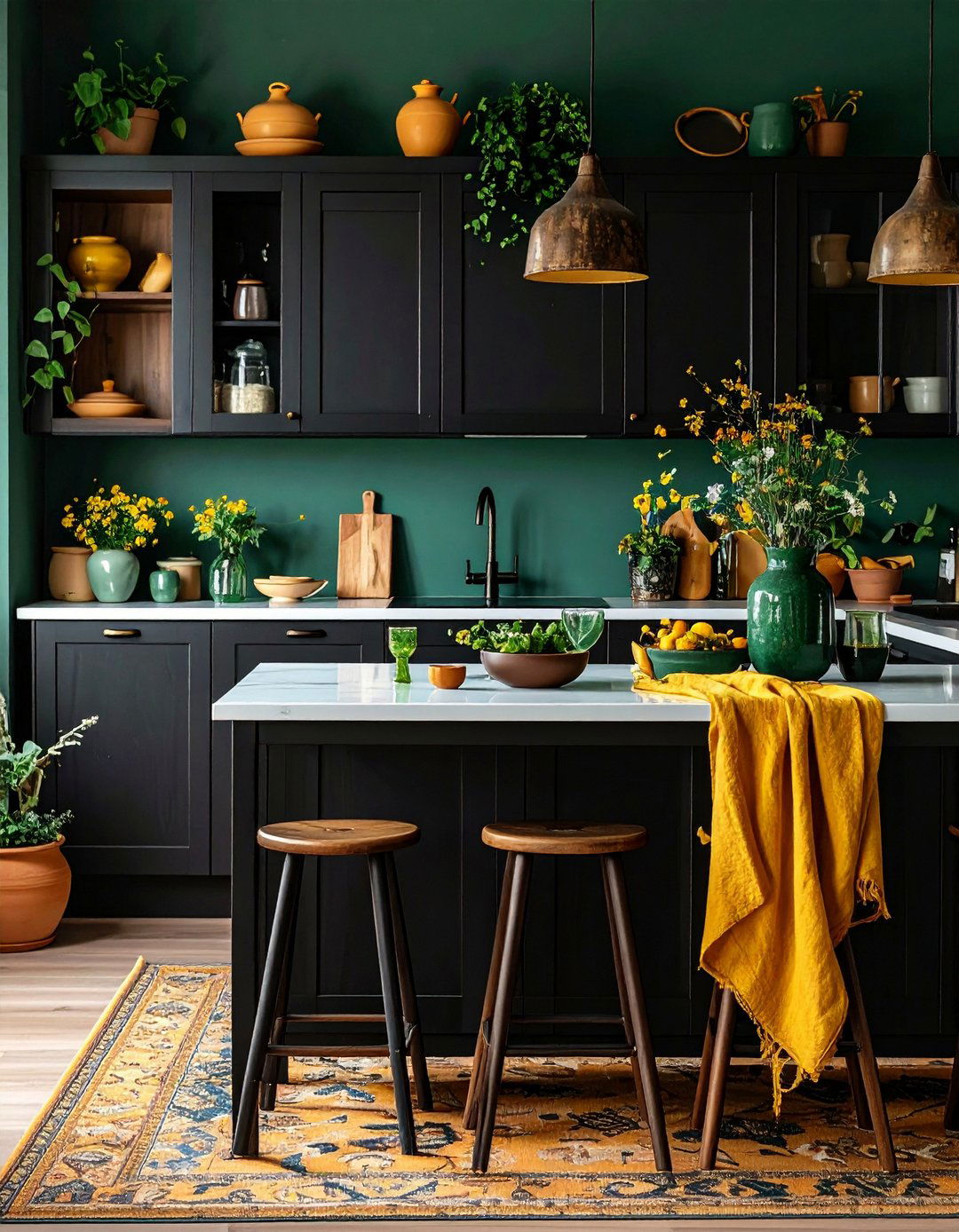
Because black and white form a neutral base, accent colors and textures shift the mood on demand. Designers encourage splashes of emerald pottery, terracotta planters, or saffron linens—any hue sings against black kitchen cabinets and gleams atop white countertops. Seasonal swaps keep the room feeling fresh without expensive renovations: pastel glassware in spring, woven jute runners in summer, cinnamon velvet stools once autumn arrives. Keep the canvas uncluttered so hero pieces command attention, and edit regularly—minimal but meaningful layers ensure the high-contrast architecture remains star of the show.
Conclusion:
From high-drama entrances to eco-smart refits, black kitchen cabinets with white countertops offer endless opportunities to craft a space that feels tailor-made, stays practical, and even boosts long-term value. Whether you lean minimalist, industrial, or classic, the powerful contrast provides a timeless backdrop for personal expression and everyday function alike.


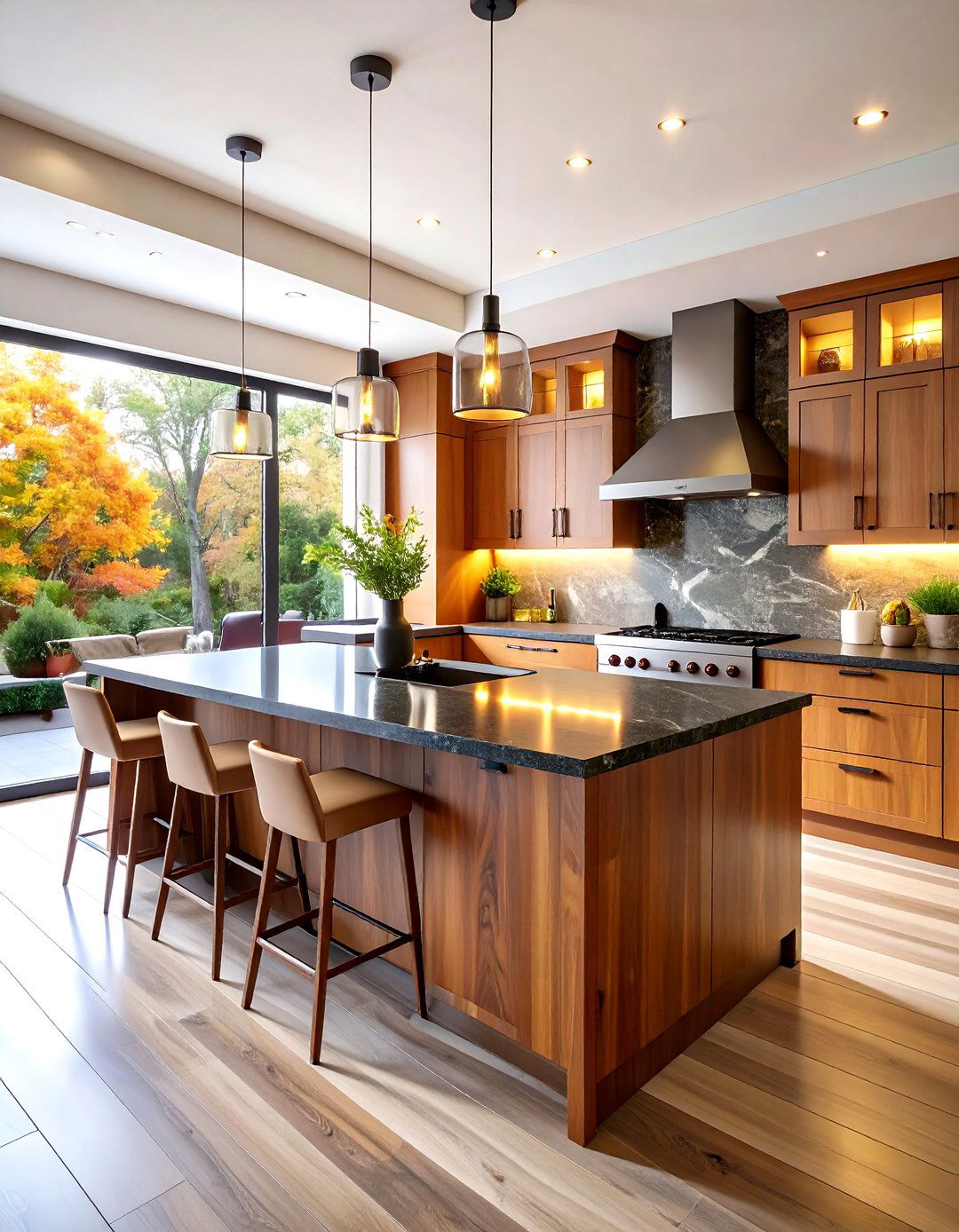
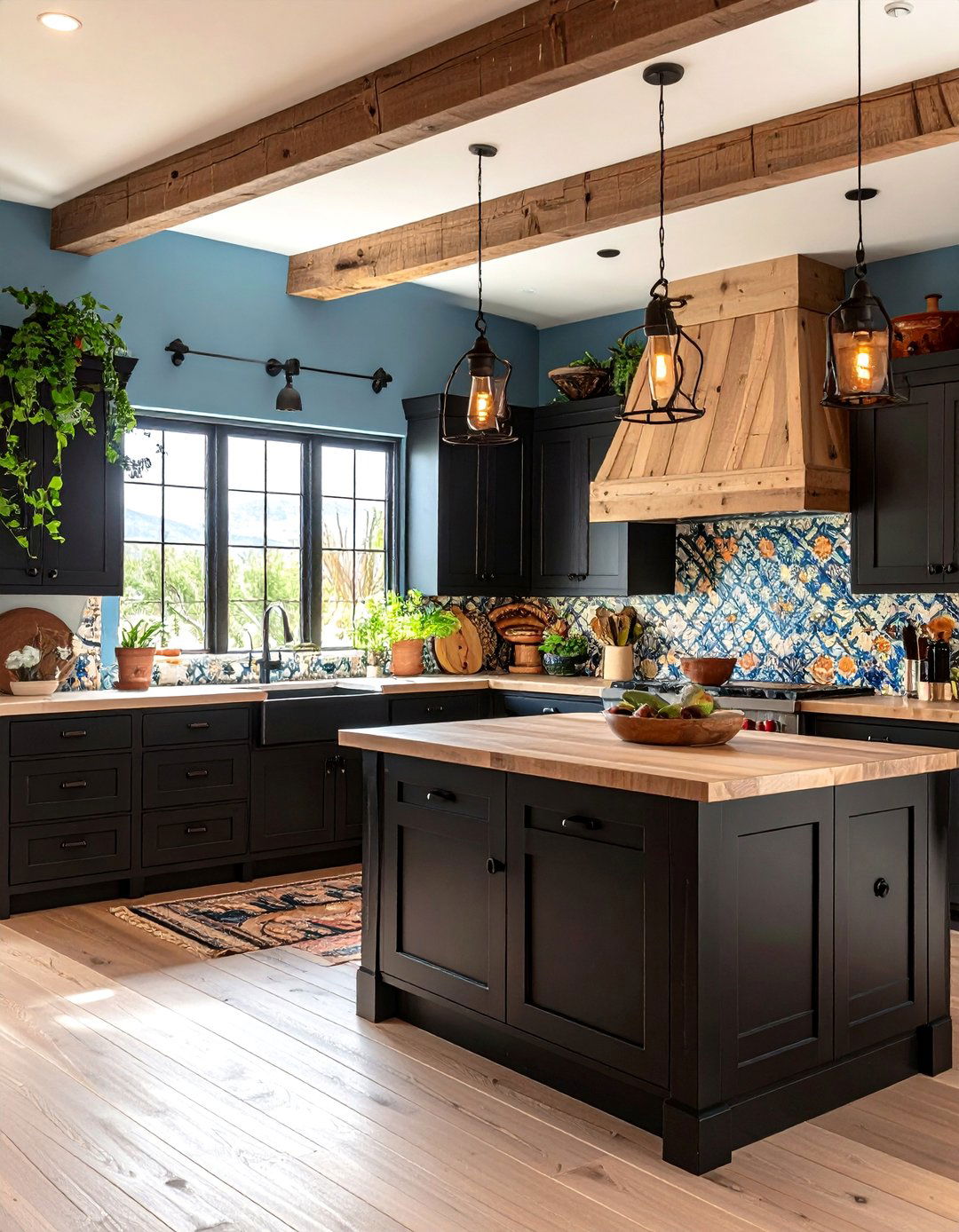
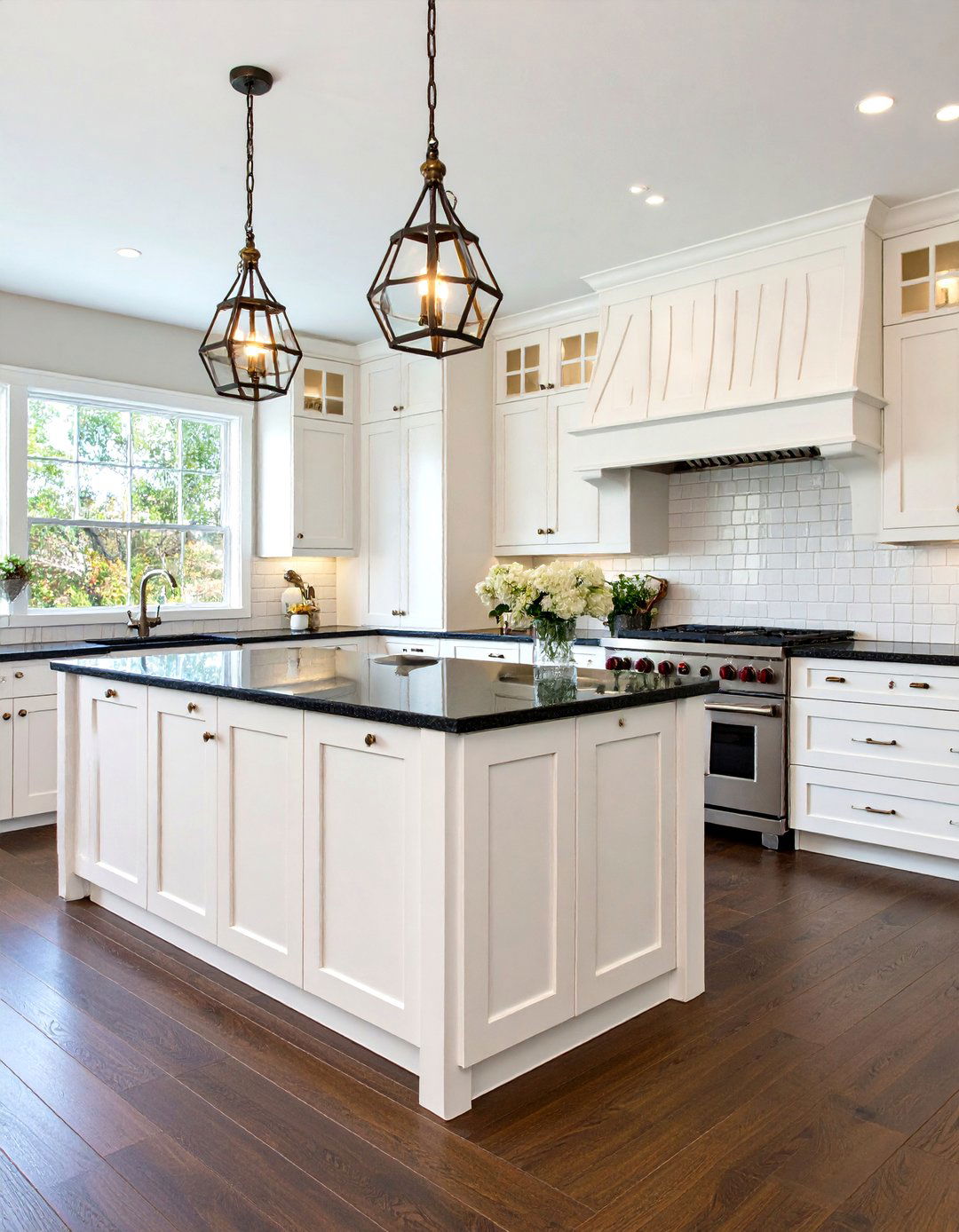

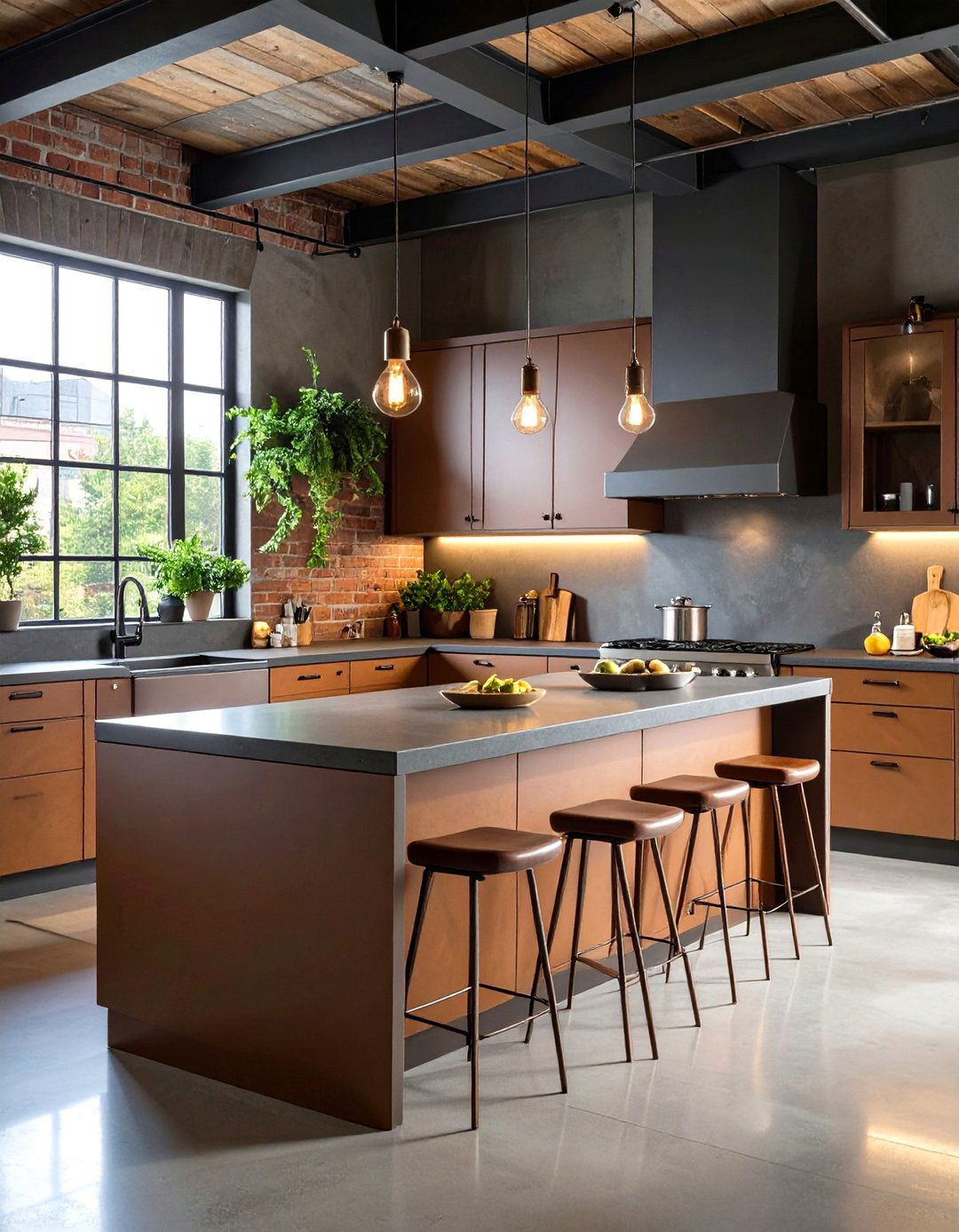
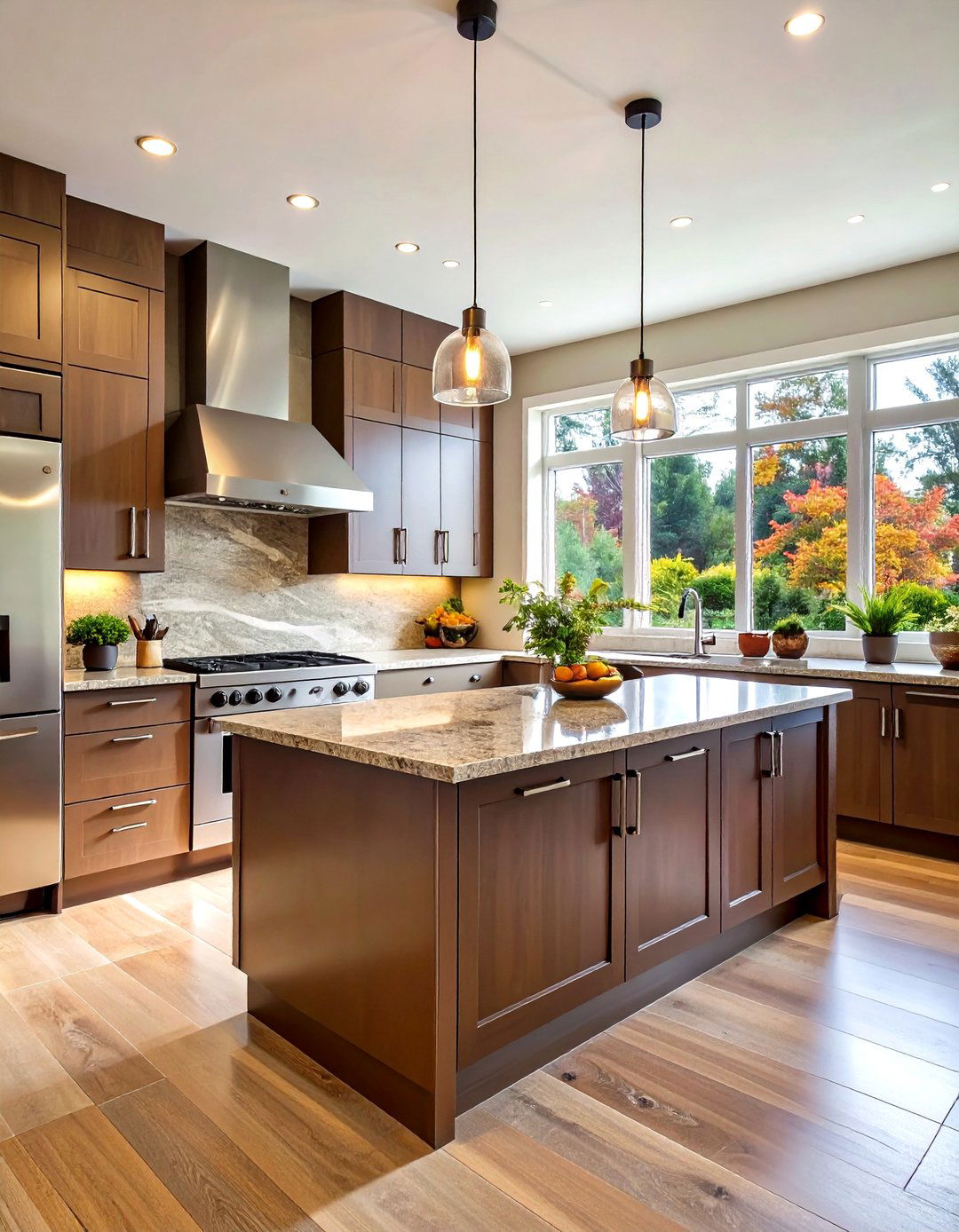
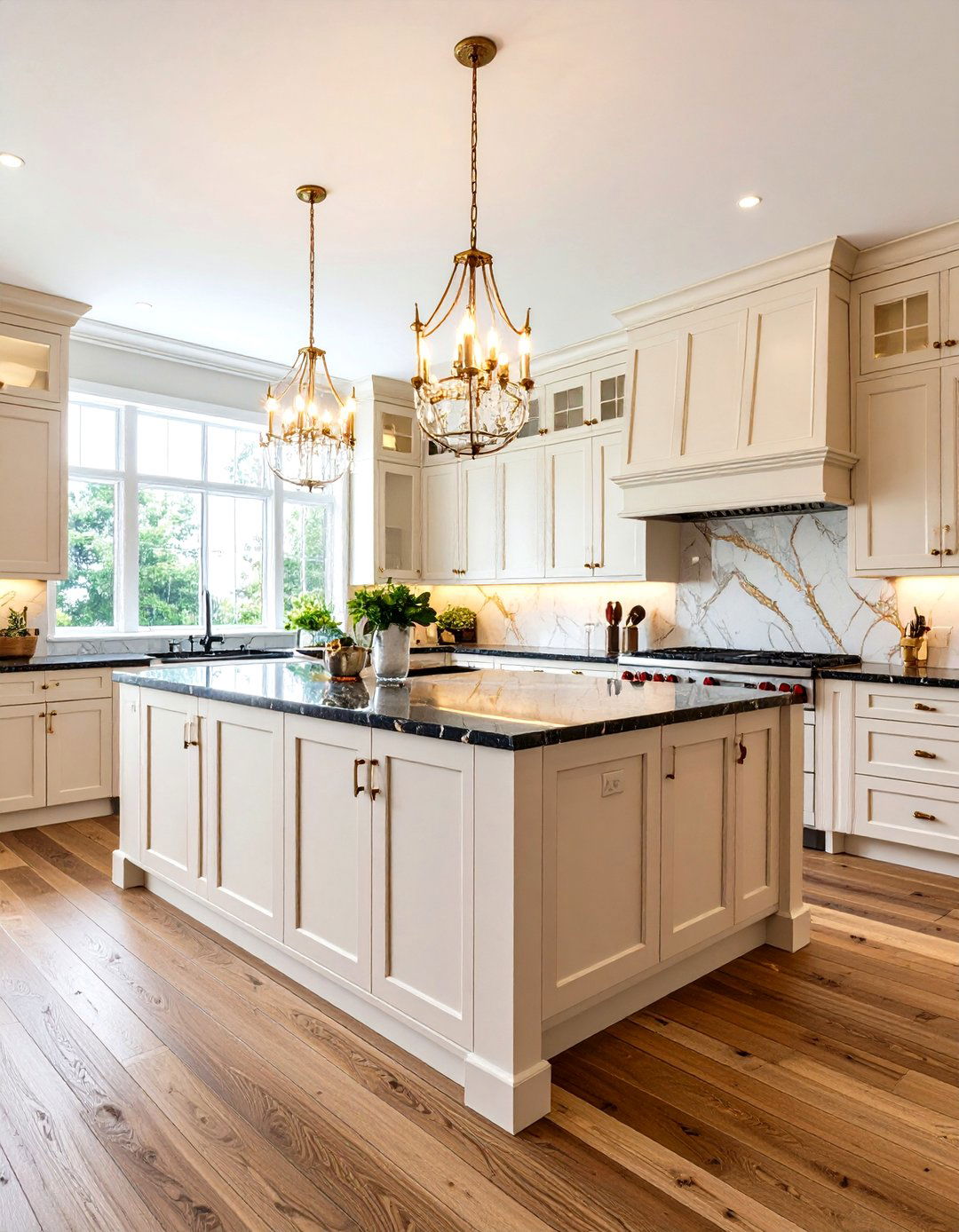
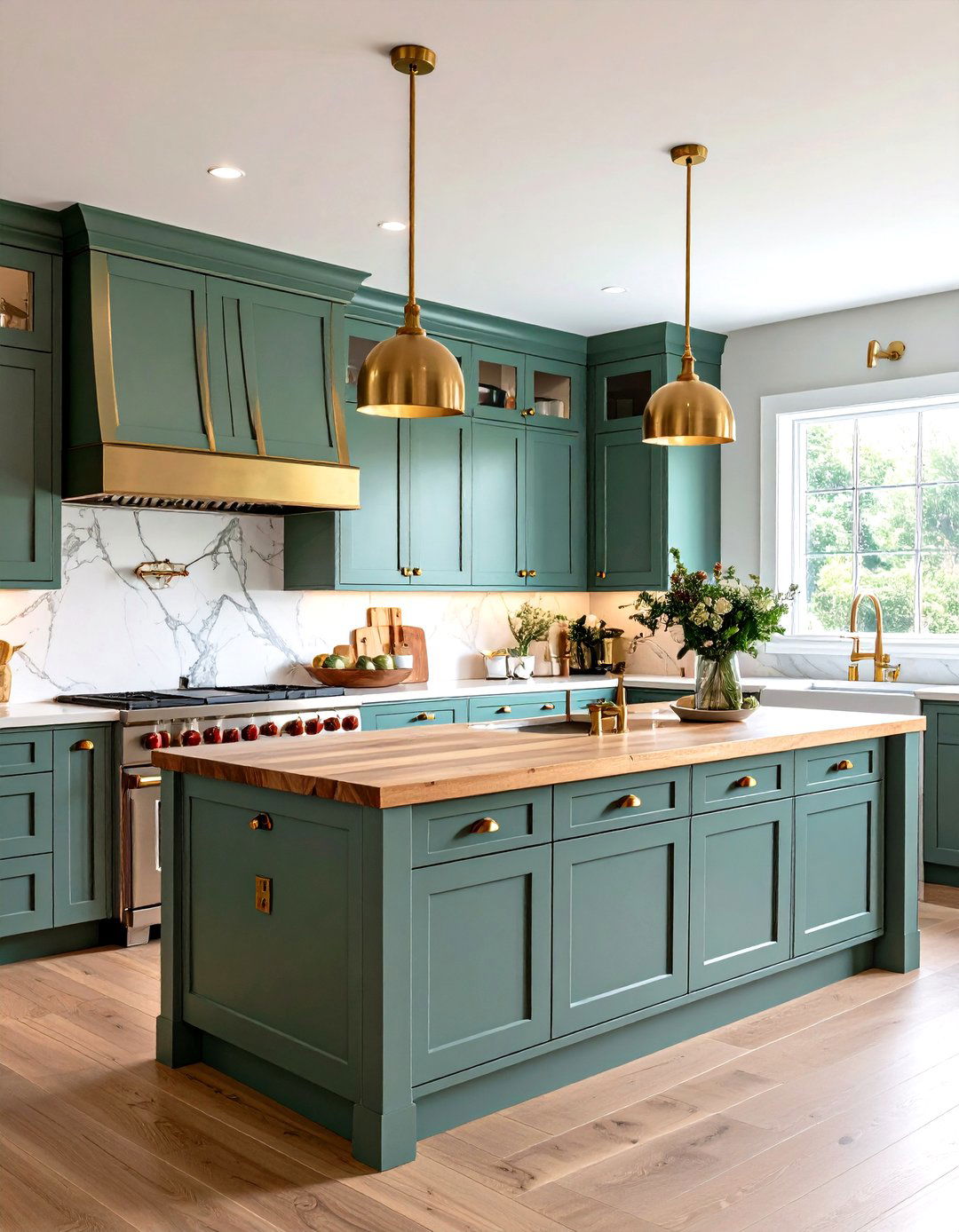
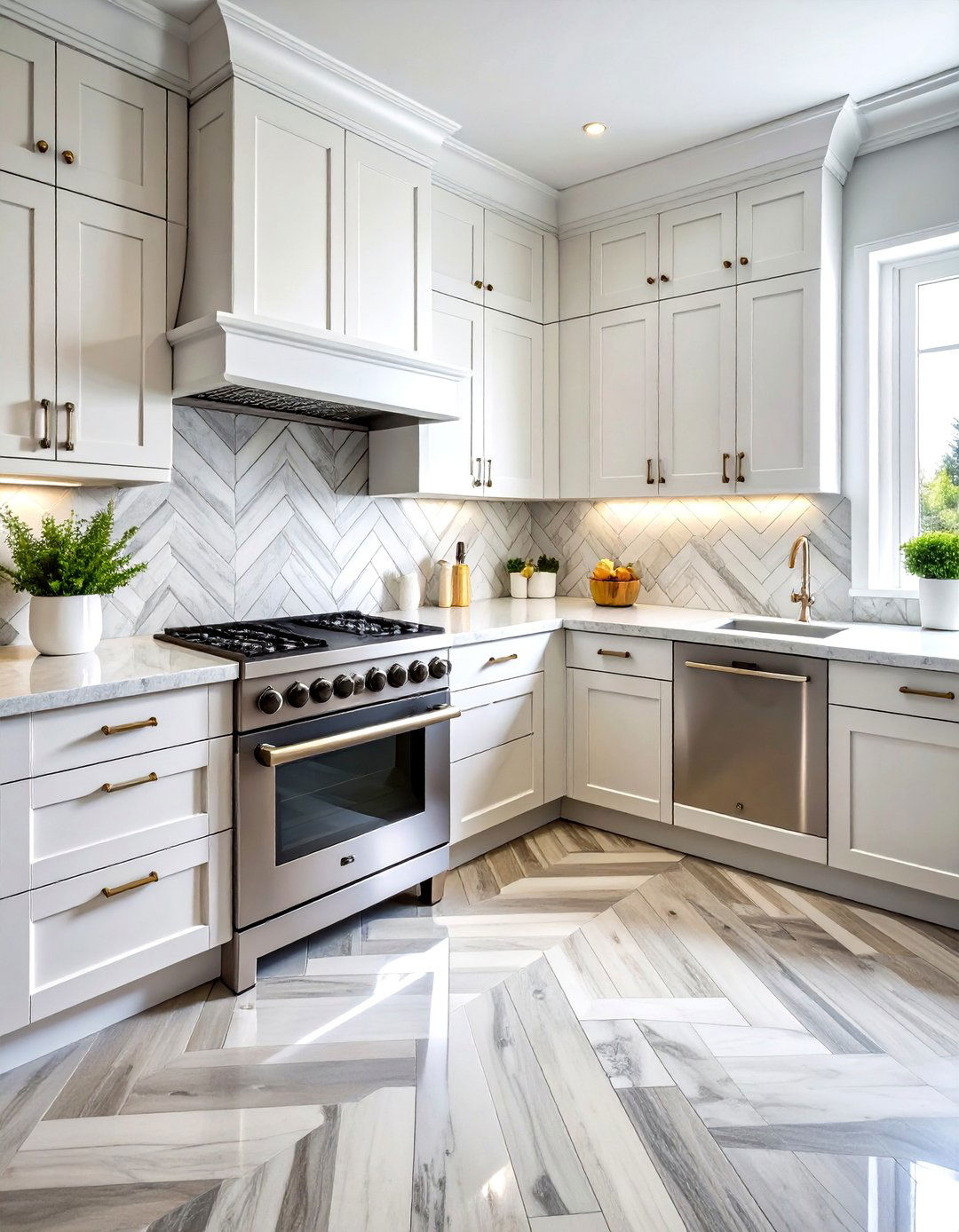


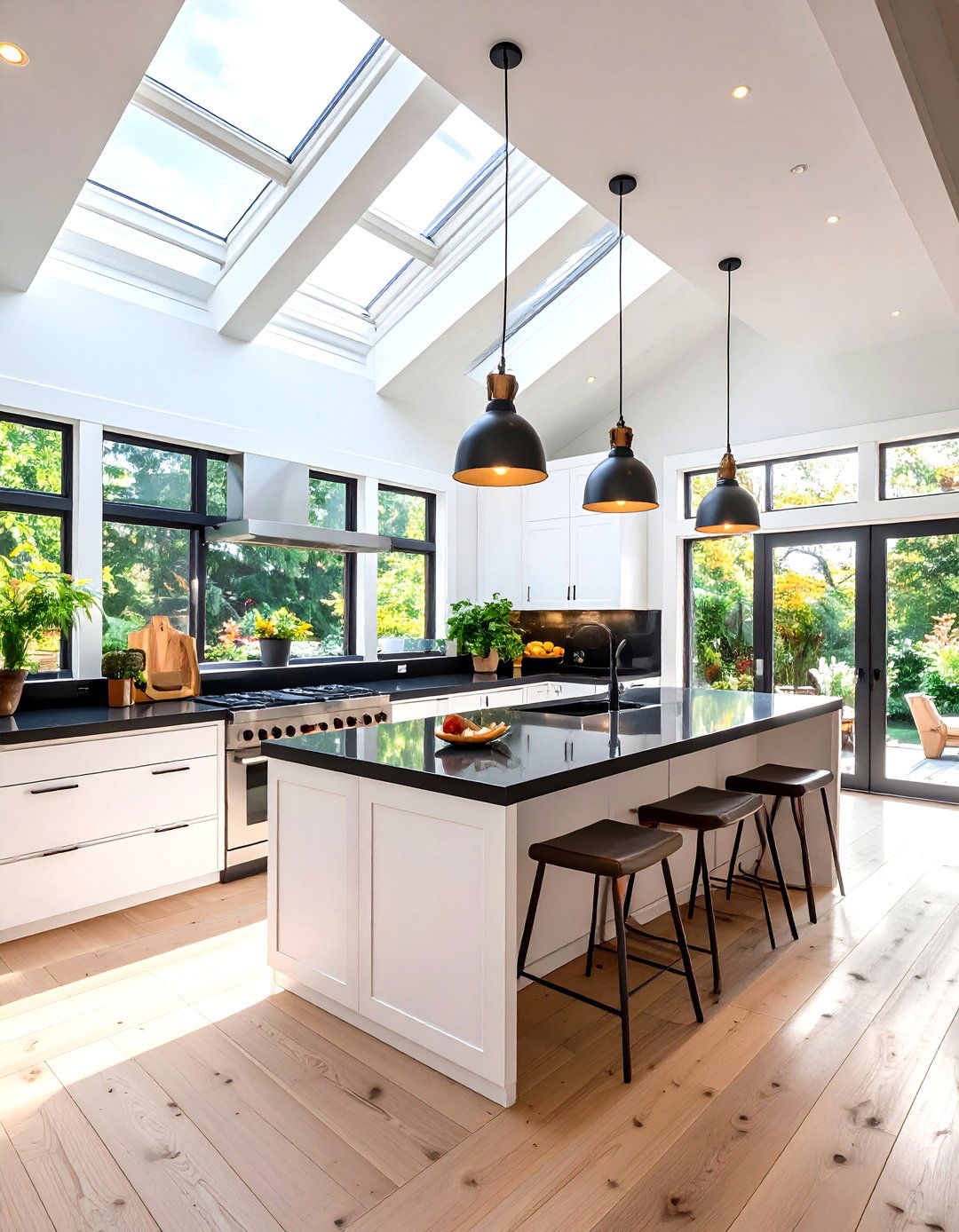
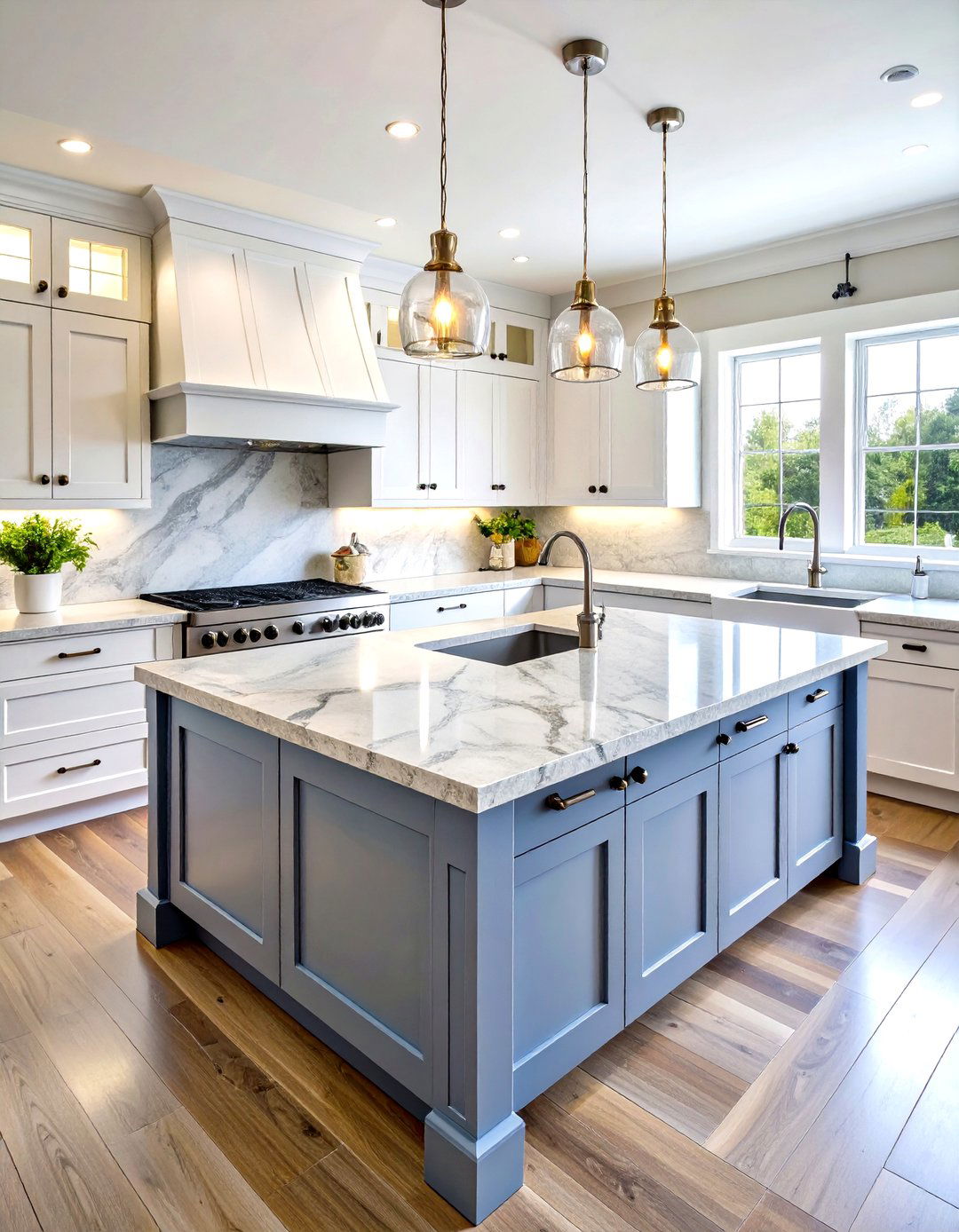
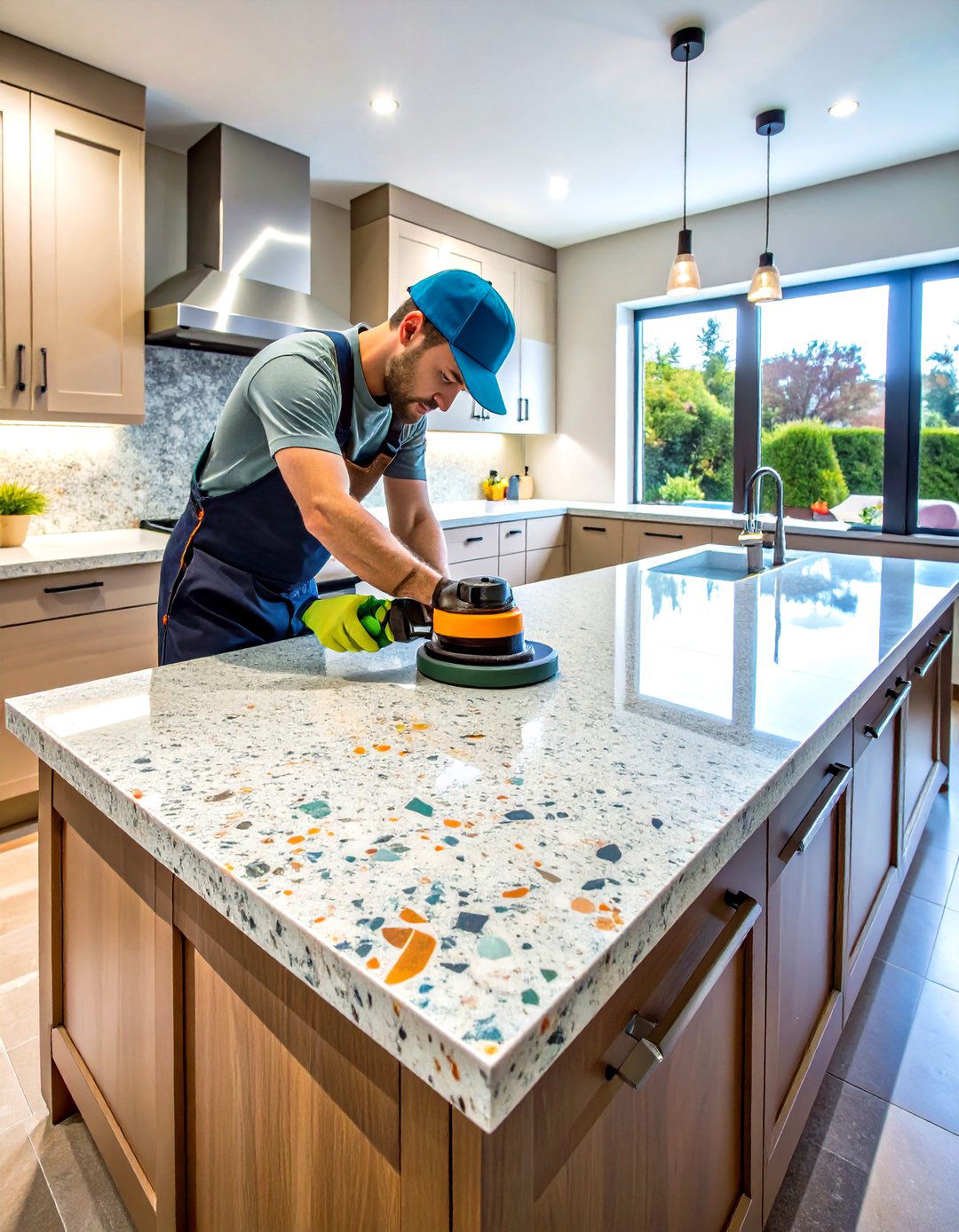
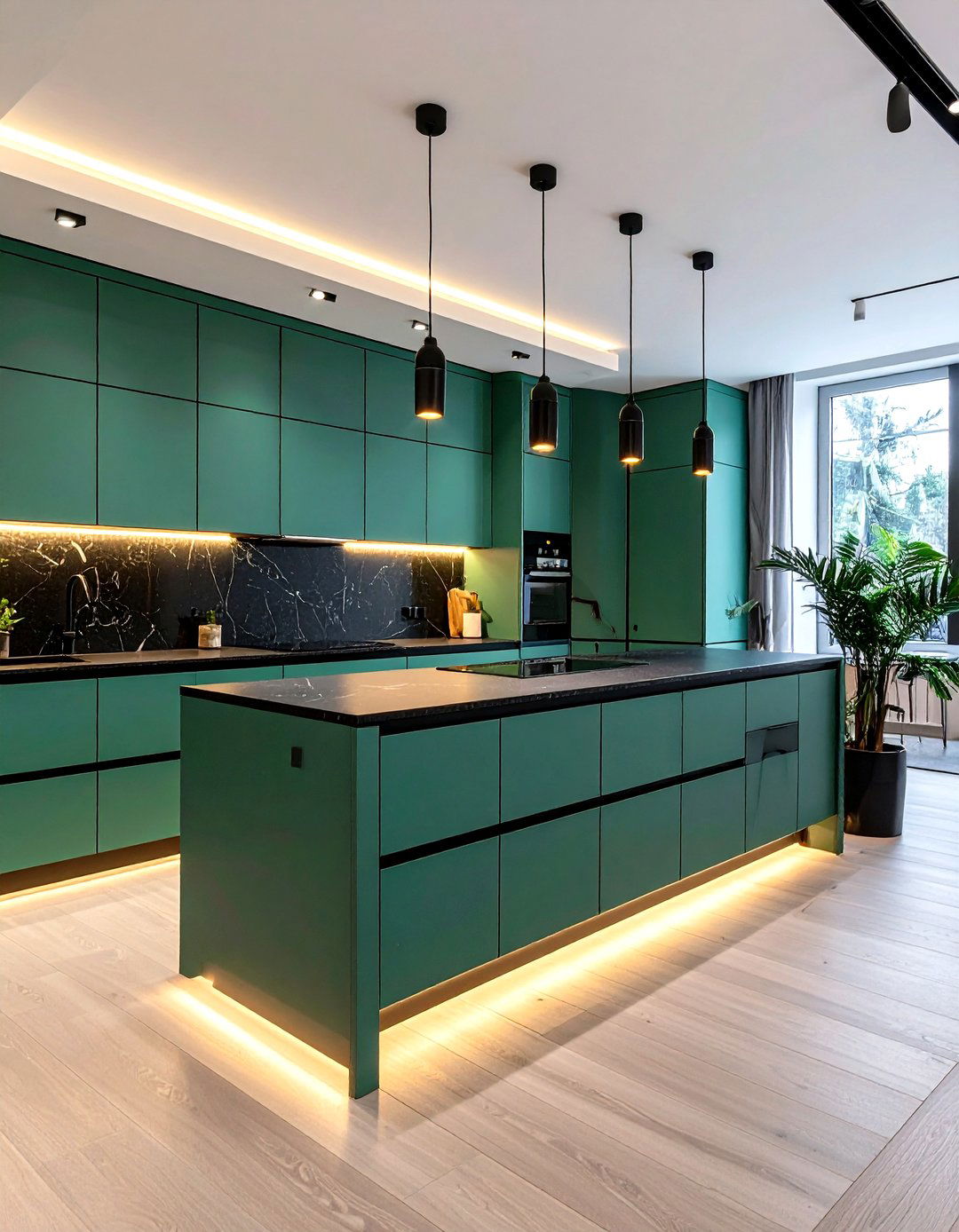
Leave a Reply